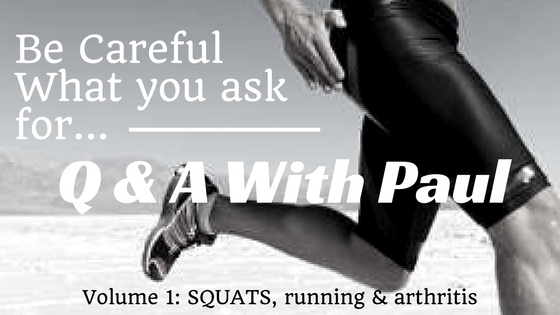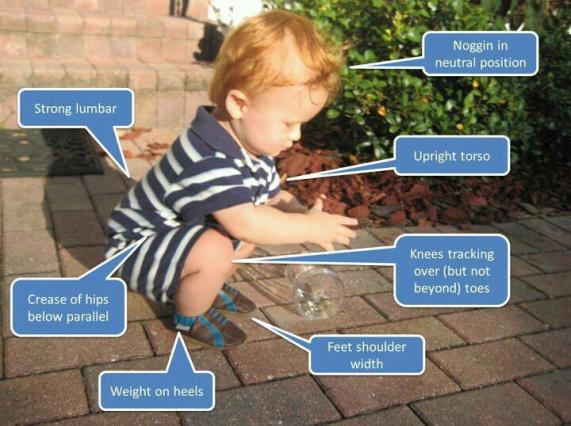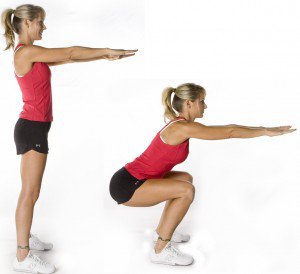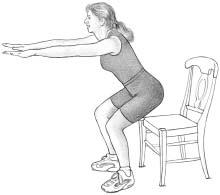
Most questions I get come in through email or text, which is great for ensuring the specificity of my answer, but it also means all other readers miss out on the information. So, today will be the first post in my Careful What You Ask For series.
Question:
“What are the safety considerations for performing squats? Specifically, what application does the squat have for runners? And what concerns exist for individuals with arthritis?”
Answer:
Wow – applications and concerns for the squat, known as “the king of all movements!” This could be a pretty involved topic but I’ll do my best to stay on point.
First off, let’s cover the basics:
The human body is meant to squat.

As soon as we can stand on two legs, we frequently sit in a deep squat position. Whenever we sit down and stand up from a chair, we are squatting. The legs and hips are some of the biggest and strongest muscles in the body not only to carry us long distances, but to offer a safe and powerful base for when we come to a rest and lower into a seated position.
However, like any other movement, the squat can be risky if performed incorrectly.
So, the best place to start is with proper “squat mechanics”

- Stand with feet shoulder width apart, toes turned slightly out, weight evenly distributed through the ball of your feet, the pinky toe, and the heel.
- Reach hands out in front for counterbalance and push your hips / butt back, keeping your lower back arched in, and shoulders / chest up.
- As hips are lowering behind you, actively push knees out to the sides. Keeping the knees wide, and preventing them from caving in, will reduce any load on the knee and ACL.
- Keep sitting back and down, almost between your legs, until you reach depth. This is dependent upon specific hip structure, mobility, and experience. Stop descending if your lower back loses its arch and starts to round, if you start to tip / lose your balance, or if any part of your foot leaves the ground.
- The squat back up should be identical – knees wide, back arched, chest high and wide – until you are standing up straight, squeezing the butt and keeping the knees “soft” (not forcibly pushing the knees back, creating hyperextension a the knee joint).
A common training wheel of sorts would be to elevate the heels about 1 inch. This will allow you to sit deeper down, without feeling like you’re going to tip over or the extending the knees too far forward.
Next, let’s look at the specific application for runners.
Running is a sport that involves the body moving in one direction, often for many miles, with a great deal of impact. This will develop some muscles while leaving others completely passive and underdeveloped. The most concerning would be the glutes and the hamstrings.
 Any exercise moving the knee and leg away from the midline of the body will target the glutes and hips…but the squat may be the most effective option because it requires balance and postural awareness, while also engaging the rest of the muscles throughout the body.
Any exercise moving the knee and leg away from the midline of the body will target the glutes and hips…but the squat may be the most effective option because it requires balance and postural awareness, while also engaging the rest of the muscles throughout the body.
My recommendation for a runner would be to become proficient in a bodyweight squat. Once 2 or 3 sets of 20 repetitions can be completed without breaking a sweat, add an elastic band around the knees, hold a dumbbell in front of the chest, or place a bar on the shoulders.
Progressing to barbell squats or a single-leg version would be a perfect goal for runners! If you want to run 26.2 miles without injury, it’s a good idea to first develop the balance, strength, and endurance to perform 20 squats on one leg.
Remember my favorite quote from Tim Gould, Doctor of Physical Therapy: “Train to run, don’t run to train.”
And finally, does the presence of arthritis contraindicate squats?
Just to clarify, the form of arthritis determines the risks.
Degenerative arthritis is caused by a breaking down of the “padding” between bones. Rheumatoid arthritis is an autoimmune condition where, simply put, offending foods have broken through the stomach lining and are wreaking havoc elsewhere in the body.
I’m going to assume we’re talking about degenerative arthritis since this is affected by activity and movement.
As always, you should consult your doctor first. No matter how cautious and properly a movement is performed, if your body doesn’t have enough cartilage to protect bones from grinding against one another, pain and further deterioration can occur.
Let’s assume that you can load and bend your knee without any pain. If so, performing a controlled squat may actually strengthen the muscles around the joints!
I have had quite a few clients with arthritis, and we usually make the following modifications:
- Progress slower, only adding 2 repetitions per set every week.
- Don’t hold any one position too long. Normally, doing a pause squat, where you sit
 and stay tight in the bottom for a count, improves mobility and strength. But the longer you “hang out” in one position, the more likely your muscles will get tired, transferring the load to the bones and joints.
and stay tight in the bottom for a count, improves mobility and strength. But the longer you “hang out” in one position, the more likely your muscles will get tired, transferring the load to the bones and joints. - Allow for more recovery and emphasize diet. Degenerative arthritis cannot be cured through diet like rheumatoid, but consuming enough vitamin D & K, magnesium, iron, and collagen (found in gelatin), can help improve bone health.
- And finally, never allow one bad repetition! If your knee joint is lacking its natural cushion, we don’t want even a millisecond to be spent in a suboptimal position.
In summary, the inclusion of properly executed squats can help improve running performance, as well as prevent injuries. Squats can also build the strength and stability of soft-tissues around the joints and improve bone density, thereby benefiting those with arthritis.
How you structure your squat training is up to you – some like to heavy barbell squats once a week, while others prefer to complete 20 repetitions of bodyweight squats at random on a daily basis.
If you need any hands-on guidance learning how to squat or developing a safe and effective program, just let me know!


